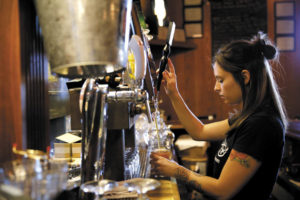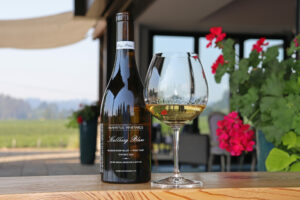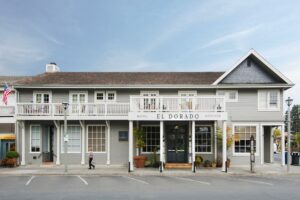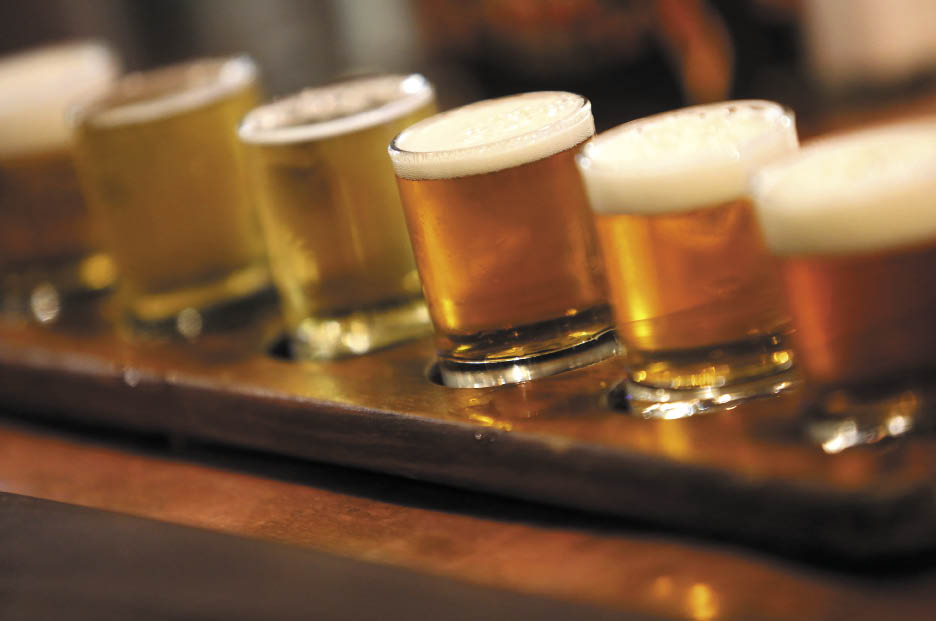Some people might think it crazy to wait in line 17 hours — much of it in cold, driving rain, no less — for a 10-ounce glass of beer.
But this is not just any beer, insists nelson Rivera, who traveled more than 400 miles from Los angeles to Santa Rosa in February to taste one of the planet’s most famous and coveted brews: Russian River Brewing Co.’s Pliny the Younger.
The limited-edition triple India Pale Ale regularly ranks in the top six in the world on beer-rating websites. It’s not easy to get, sold for only two weeks a year at the downtown Santa Rosa brewpub and select locations. But it is well worth the wait, Rivera said, savoring a glass of the amber-colored beer with two friends as they dried out inside the packed brewpub and celebrated the end of their quest.
“Yes, I would do it again,” said Rivera, 23, as he enjoyed his seat at the bar and status as first in line to sip this year’s Pliny release.
Thousands make a pilgrimage to Santa Rosa every February to taste Pliny the Younger, an extra-hoppy and beautifully balanced ale with a potent 10.25 percent alcohol content. While here, visitors spend millions of dollars on lodging, meals, entertainment and more beer. In 2013, the two-week Pliny release brought some $2.4 million in economic activity to the region, according to the most recent estimates.
Pliny the Younger may be the most acclaimed beer made in Sonoma, but a scrappy and ambitious group of craft breweries is transforming a place known as the heart of California’s Wine Country into a region renowned for its stellar lineup of beers.
The number of craft breweries have doubled in Sonoma County since 2011. Two of the 22 local breweries — Lagunitas Brewing Co. in Petaluma and Bear Republic Brewing in Healdsburg and Cloverdale — are now ranked among the 50 largest craft breweries in the United States.
Up-and-comers including Fogbelt Brewing Co. in Santa Rosa, HenHouse Brewing Co. and 101 North Brewing Co. in Petaluma, and St. Florian’s Brewery in Windsor also are attracting notice. Though they are small in production volume — the equivalents of the so-called boutique wineries — they are big on cachet as word spreads of Sonoma’s ale and lager riches.
Local brewers have an effect on craft beer “like that of the Mondavi family for wine in Napa,” said Ben Stone, executive director of the Sonoma County economic Development Board. “They have created an awareness of Sonoma County, an image for Sonoma County. It really has become a hallmark for Sonoma County.”
Natalie Cilurzo, co-owner of Russian River Brewing Co., said millennials are particularly attached to craft beer because many of their parents made the switch to the first generation of full-flavored beers that began appearing in the 1980s. “That’s what they grew up with. Their parents drank Sierra Nevada,” she said. “Our parents didn’t drink Sierra Nevada. Our parents drank Miller Lite, Heineken.”
“That’s all they know,” her brewer husband, Vinnie, chimed in.
Even those in the Sonoma wine industry are taking notice, especially as craft beer attracts millennials in the highly coveted 21-to- 35 age demographic.
“Craft beer is a significant challenger for basic wines and wine needs to up its game to compete,” said Mike Veseth, editor of the Wine Economist blog. “The simplest wines are challenged by the relative value and interest that craft beers present.”
The Brewers Association, which represents U.S. craft brewers, tracks the 50 largest artisan breweries, by volume. D.G. Yuengling & Son of Pottsville, Pa., ascended to No. 1 last year, displacing Boston Beer Co., the maker of Sam Adams, at more than 6 million barrels a year (though there is some consternation that the company is considered a craft brewer). Lagunitas is No. 6, and racing to expand nationally and even internationally. Bear Republic is No. 39, and then it’s a big drop to the rest of the Sonoma pack.
America’s $100 billion annual beer industry continues to be dominated by the “Big Three,” Budweiser, Miller and Coors, yet their executives are nervous enough to create their own “craft” brands (Blue Moon and Shock Top, for example) or to buy existing craft breweries, as Budweiser did with 10 Barrel Brewing Co. in Bend, Ore. even though the little guys claim just 11 percent of the nation’s total beer production, their output grew a remarkable 18 percent in 2014, according to the Brewers association. Overall beer production was up by only 0.5 percent, attributed to a decline suffered by the big brewers. The growth has attracted private equity firms looking for investment opportunities.
Lagunitas is an imposing presence in and out of Sonoma, with owner Tony Magee’s brewery producing almost 75 percent of the beer made in the county. Production at the Petaluma brewery and a new Chicago facility will likely surpass 850,000 barrels this year, about 40 percent more than in 2014.
It’s a much different story for Lagunitas’ across-the-road neighbor, 101 North Brewing Co., which opened in September 2012. It’s on the verge of going into the black for the first time and its owners (brothers Joel, Jake and Joe Johnson, and their friends, John Brainin, John Lilienthal and Anthony Turner) use a second-hand barrel system they purchased in 2010 from Lake Placid Brewing Co. in Plattsburgh, N.Y., for a $100,000 low-bid offer that was immediately accepted.
“Those guys across the way are so much larger than us. We are quite some time away from even being some semblance of their size,” said Joel Johnson, 101 north’s brewmaster.
The company awaits delivery of two 90-barrel tanks to increase production and keep up with retailer demands; it currently has three tanks. It produced 1,750 barrels last year, a 50 percent increase in annual production. The partners had to cobble together the $1 million needed to get the brewery off the ground in 2010. Recent distribution deals with Safeway and Costco are cause for celebration at 101 north, and nearly 80 local and regional pubs serve its beer, including the popular Heroine IPA.
Johnson, 45, looks the part of new-generation brewmaster, with a soul patch, earrings in both ears and a neck tattoo. But he also has the bona fides. He brewed for Bear Republic and honed his skills making its flag- ship beer, Racer 5 IPA. Experience like that has helped 101 North compete in a crowded market, especially for the hoppy IPAs that are ubiquitous on the West Coast.
“We would like to say in 10 or 15 years that we are on our way to being more than just a speck on the map,” Johnson said. “If we could get on the top-50 brewery (list) size-wise, it would be great.”

The local artisan beer industry began in 1976, when Jack McAuliffe opened New Albion Brewing Co. in Sonoma. It is widely regarded as the first craft brewery in the modern era, though no longer based here. There is also a history of hop production in the region. In 1858, William Thomas Ross grew hops on one of the first farms near Forestville. Hops were a major crop in Sonoma County from 1880 to 1950, reaching a high of 3 million pounds in the 1930s.
Following in New Albion’s footsteps, the Hopland Brewery opened in 1983 in Mendocino County as the second brewpub in the U.S. after Prohibition and the first in California. Finally craft brewers had a place for patrons to eat and drink their beers. The brewery, which later became Mendocino Brewing Co., attracted a legion of fans, many of whom were home brewers who later expanded the popularity of full-flavored beers in the 1980s. That group included Ken Grossman of Sierra Nevada and Dean Biersch of Gordon Biersch Brewing Co. in Palo Alto.
“Here’s this brewpub and it had this atmosphere that was unbelievable,” Biersch said, describing the Hopland Brewery. In his latest effort, Biersch has tried to recreate that excitement by opening three local HopMonk Tavern Brewpubs (Sebastopol, Sonoma and Novato), upscale beer gardens that focus on food pairings with beer.
However, it was home brewers who helped set the stage for what craft brewing has become here, and they keep on coming. Some dream of turning their hobby into a business, and look up to those who have already made it. Grossman started as a home brewer and even operated a supply store in downtown Chico called The Home Brew Shop. Now younger brewers can gain experience at these established places, just like the guys at 101 North.
“I probably respond to a dozen to two dozen emails a week from home brewers,” said Russian River Brewing’s Vinnie Cilurzo.
Specialization is the current trend in the craft-beer industry and an especially vital point in Sonoma, where brewers such as Cilurzo, Magee and Bear Republic’s Norgrove family have made an indelible mark with their flagship IPAs. you can’t go into a bar in the county without encountering at least one IPA on tap, and likely a few more.
“It’s getting more challenging and you certainly have to differentiate more,” said Bart Watson, chief economist with the Brewers association.
That’s what Steve Doty is doing with his one-man shop, Shady Oak Barrel House in Santa Rosa, which specializes in sour beers and those brewed with Brettanomyces yeast. Like the county’s other famous beverage, some of his beers can take up to two years to age. His brews, including Funkatronic, are available at Bottle Barn and the Rincon Valley Tap Room & Bottle Shop, both in Santa Rosa, although availability varies be- cause of Doty’s small production.
“There are very few people who are specializing in things,” Doty said. “That’s why I don’t think we are even close to crowded.”
As the demand for craft beer skyrockets across the country, a new brewery opens every 16 hours, Watson said. The local contribution is significant. A report by the Sonoma County economic Development Board found that craft brewing pumped $123 million into the local economy in 2012, creating almost 500 jobs and another 179 positions indirectly. Hotels and eateries that serve those who visit Beer Country, taxi services and gas stations, even convenience stores that sell aspirin to those who have overindulged, contribute to the economy, thanks to beer.
Kelly Jung said she was impressed that Vinnie Cilurzo came out and greeted customers in line.
Cilurzo said most of the well-known craft brewers have not allowed success to go to their heads. after all, they started as fans, then became home brewers, and still retain the enthusiasm they first had when they were cooking grains, malt and water in their kitchens.
“It’s how we did it. It’s how so many did it,” he said. “It’s about not forgetting your roots.”










